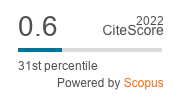A Present and a Non-Present Body—Experiencing the Body by Female Sex Workers in Commercial Sexual Relations
DOI:
https://doi.org/10.18778/1733-8077.14.2.03Keywords:
Female Sex Workers, Commercial Sex, Body, Qualitative ResearchAbstract
Making women’s bodies accessible to men in the commercial context is related to specific ways of experiencing it. The purpose of the article is to discuss the category of a non-present, selectively present, and present body, which refers to ways in which female sex workers experience their bodies during commercial sex acts. There will also be conditions listed that correspond to the occurrence of each of these categories. The article is based on qualitative data (mainly unstructured interviews), which were analyzed in accordance with the procedures of grounded theory methodology.
Downloads
References
Boynton, Petra. 2002. “At the End of the Day, It’s a Job”: Discursive Practices around Sex Work. London: Department of Psychiatry and Behavioural Sciences, Royal Free and University College Medical School.
Google Scholar
Byczkowska, Dominika. 2009. “What Do We Study Studying Body? Researcher’s Attempts to Embodiment Research.” Qualitative Sociology Review V(III):100-112.
Google Scholar
DOI: https://doi.org/10.18778/1733-8077.5.3.07
Byczkowska, Dominika. 2012. Ciało w tańcu. Analiza socjologiczna. Lodz: Wydawnictwo Uniwersytetu Łódzkiego.
Google Scholar
DOI: https://doi.org/10.18778/7525-649-9
Choudhury, Shonali Mona. 2010. “‘As Prostitutes, We Control Our Bodies’: Perceptions of Health and Body in the Lives of Establishment-Based Female Sex Workers in Tijuana, Mexico.” Culture Health & Sexuality 12(6):677-689.
Google Scholar
DOI: https://doi.org/10.1080/13691051003797263
Collins, Randal. 2011. Łańcuchy rytuałów interakcyjnych. Cracow: Zakład Wydawniczy Nomos.
Google Scholar
Coy, Maddy. 2009. “This Body Which Is Not Mine. The Notion of the Habit Body, Prostitution and (Dis)Embodiment.” Feminist Theory 10(1):61-75.
Google Scholar
DOI: https://doi.org/10.1177/1464700108100392
Day, Sophie. 1994. “What Counts as Rape? Physical Assault and Broken Contracts: Contrasting Views of Rape amongst London Sex Workers.” Pp. 127-189 in Sex and Violence: Issues in Representation and Experience, edited by P. Harvey and P. Gow. London: Routledge.
Google Scholar
Davidson, Julia O’Connell. 1998. Prostitution, Power and Freedom. Cambridge: Polity Press.
Google Scholar
DOI: https://doi.org/10.3998/mpub.10885
Epele, Maria. 2001. “Excess, Scarcity and Desire among Drug-Using Sex Workers.” Body & Society 7(2-3):161-179.
Google Scholar
DOI: https://doi.org/10.1177/1357034X0100700209
Farley, Melissa and Vanessa Kelly. 2000. “Prostitution: A Critical Review of the Medical and Social Sciences Literature.” Women & Criminal Justice 11(4):29-64.
Google Scholar
DOI: https://doi.org/10.1300/J012v11n04_04
Glaser, Barney G. and Anselm L. Strauss. 1967. The Discovery of Grounded Theory. Strategies for Qualitative Research. New York: Aldine Publishing Company.
Google Scholar
Goffman, Erving. 2000. Człowiek w teatrze życia codziennego. Warsaw: Wydawnictwo Naukowe PWN.
Google Scholar
Goffman, Erving. 2006. Rytuał interakcyjny. Warsaw: Wydawnictwo Naukowe PWN.
Google Scholar
Hall, Edward. 2009. Ukryty wymiar. Warsaw: Warszawskie Wydawnictwo Literackie.
Google Scholar
Hochschild, Arlie. 1983. The Managed Heart. Berkeley, CA: University of California Press.
Google Scholar
Hoigard, Cecilie and Liv Finstad. 1992. Backstreets: Prostitution, Money and Love. Cambridge: Polity Press.
Google Scholar
Jakubowska, Honorata. 2009. Socjologia ciała. Poznan: Wydawnictwo Naukowe UAM.
Google Scholar
Jakubowska, Honorata. 2012. “Ciało jako przedmiot badań socjologicznych – dylematy, pominięcia, możliwości.” Przegląd Socjologii Jakościowej 8(2):12-31.
Google Scholar
DOI: https://doi.org/10.18778/1733-8069.8.2.02
Leathers, Dale. 2007. Komunikacja niewerbalna: zasady i zastosowania. Warsaw: Wydawnictwo Naukowe PWN.
Google Scholar
McLeod, Eileen. 1982. Working Women: Prostitution Now. London: Croom Helm.
Google Scholar
Niedbalski, Jakub. 2015. “Przemiany percepcji własnego ciała przez osoby z niepełnosprawnością fizyczną uprawiające sport.” Studia Socjologiczne 3:221-240.
Google Scholar
O’Neill, Maggie. 1996. “Researching Prostitution and Violence: Towards a Feminist Praxis.” Pp. 130-147 in Women, Violence and Male Power, edited by M. Hester, L. Kelly, and J. Radford. London: Open University Press.
Google Scholar
Oerton, Sarah and Joanna Phoenix. 2001. “Sex/BodyWork: Discourses and Practices.” Sexualities 4:387-412.
Google Scholar
DOI: https://doi.org/10.1177/136346001004004001
Phoenix, Joanna. 1999 Making Sense of Prostitution. Cambridge: Polity Press.
Google Scholar
DOI: https://doi.org/10.1057/9780333985472
Phoenix, Joanna. 2000. “Prostitute Identities: Men, Money and Violence.” British Journal of Criminology 40(1):37-55.
Google Scholar
DOI: https://doi.org/10.1093/bjc/40.1.37
Rapley, Tim. 2007. Doing Conversation, Discourse and Document Analysis. London: Sage.
Google Scholar
DOI: https://doi.org/10.4135/9781849208901
Sanders, Teela. 2002. “The Condom as Psychological Barrier: Female Sex Workers and Emotional Management.” Feminism & Psychology 12:561-566.
Google Scholar
DOI: https://doi.org/10.1177/0959353502012004016
Sanders, Teela. 2005. “‘It’s Just Acting’: Sex Workers’ Strategies for Capitalizing on Sexuality.” Gender, Work and Organization 12(4)319-342.
Google Scholar
DOI: https://doi.org/10.1111/j.1468-0432.2005.00276.x
Strauss, Anselm and Juliet Corbin. 1990. Basics of Qualitative Research. London: Sage.
Google Scholar
Ślęzak, Izabela. 2012. “Alcohol Use as a Work Factor among Female Sex Workers in Escort Agencies.” Alcoholism and Drug Addiction 25(4):E33-E52.
Google Scholar
Ślęzak, Izabela. 2016. Praca kobiet świadczących usługi seksualne w agencjach towarzyskich. Lodz: Wydawnictwo Uniwersytetu Łódzkiego.
Google Scholar
Warr Deborah J. and Priscilla M. Pyett. 1999. “Difficult Relations: Sex Work, Love and Intimacy.” Sociology of Health and Illness 21:290-309.
Google Scholar
DOI: https://doi.org/10.1111/1467-9566.00157
Weitzer, Ronald. 2005. “New Directions in Research on Prostitution.” Crime, Law & Social Change 43:211-235.
Google Scholar
DOI: https://doi.org/10.1007/s10611-005-1735-6
Wesely, Jennifer K. 2002. “Growing Up Sexualised: Issues of Power and Violence in the Lives of Exotic Dancers.” Violence Against Women 8(10):1182-1207.
Google Scholar
DOI: https://doi.org/10.1177/107780120200801003
Wojciechowska, Magdalena. 2012. Agencja towarzyska – (nie)zwykłe miejsce pracy. Cracow: Nomos.
Google Scholar











